After you have decided to become a beekeeper and have bought a couple of families, the time comes for the need for new hives. Families are growing and swarming, and they need to be deposited in new houses. You can, of course, buy ready-made, but second-hand buy is dangerous. It is not known what diseases can be bought with them, and they bite at new prices. One thing remains - to make beehives for bees with your own hands according to the drawings. If you know all the rules of manufacture, it is not difficult.
In this article we will just talk about making hives with your own hands, the right sizes and drawings for them. We learn what a hive is a sunbed and how to make it.
Table of contents
Materials needed for making a beehive
In ancient times, beekeepers mined honey in the hollows of trees, then began to hollow out decks for bees. With the development of beekeeping, they began to make evidence for bees with their own hands of different designs, and the material on them goes different.
Tree
A classic option for making beehives. In such houses, bees feel in natural conditions, close to natural. The best breed of wood for making will be cedar, although you can and linden, aspen. These hives breathe better, they smell good and they are dry.
The hives of aspen and linden in winter require additional insulation. And these are expensive materials.
Some beekeepers are engaged in the manufacture of hives with their own hands from cheaper materials. It is a pine, spruce, fir.But in such evidence bees are not comfortable. They collect moisture and tar, especially in new. Coniferous smell. Well there is only one thing in them, it is warm in them and minimal warming is required for the winter.
Plywood
Durable and ecological material. A house made of it must be covered with paints and insulated with polystyrene foam inside, then it will be dry and warm in it. But plywood is afraid of moisture and requires constant and proper care.
Styrofoam
Modern material used by beekeepers for the manufacture of hives. It has a low cost and does not require additional insulation in winter.
Styrofoam
The most economical option. It is possible to use packaging from household appliances. The plus of such material is its lightness even with filled frames. Excellent thermal insulation. The disadvantage of this material is its fragility and constant color, so as not to crumble from exposure to sunlight.
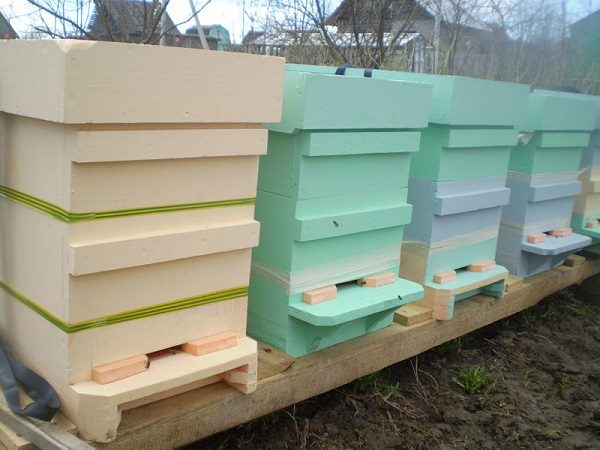
Polyurethane
Excellent thermal insulation properties. Does not decay, does not decay. It does not develop fungus and bacteria.It does not pass moisture and it does not accumulate inside. He does not like to gnaw bees, mice and birds.
Having carefully studied the characteristics of the material, you can proceed to the construction of the hive. Consider the options for the construction of wooden and foam houses.
Types and designs of hives
For the maintenance of bees used several types of hives differing in design, volume, material and functionality. To provide the bees with suitable housing means to create good conditions for them to live and work, and themselves a good harvest of honey.
Houses for bees are divided by design:
- collapsible;
- nonseparable.
Almost no one uses the latter due to the complexity of care.. All beekeepers use frame hives where the number of frames may vary. Popular hive lounger on the frame 24, made with his own hands. However, there are options for 16 and 20 frames.

In turn, the frame hives are divided into:
- horizontal;
- vertical.
Horizontal or "lounger" consists of one body. Expansion goes to the sides.It is easy to work with such evidence, to change the number of frames, but they have a drawback - they are cumbersome and heavy.
Vertical also consist of several buildings. Such form differs in ease and mobility.
In both forms, several sections are used. They are separated by partitions, which allows you to change the volume in all directions.
You will also be interested to know:
- What to do when a bee sting.
- How to apply royal jelly in cosmetology and medicine.
- How to use propolis tincture at home.
Popular designs
Dadanovsky
Used in almost all apiaries. It is made of wood (cedar, spruce, pine, linden, aspen). Differs in simplicity and spaciousness. It consists of 12 frames and can be added, as the family grows, with shops or buildings. In winter, bees are kept in the nesting compartment. With the onset of heat and an increase in the family they are put in bodies.
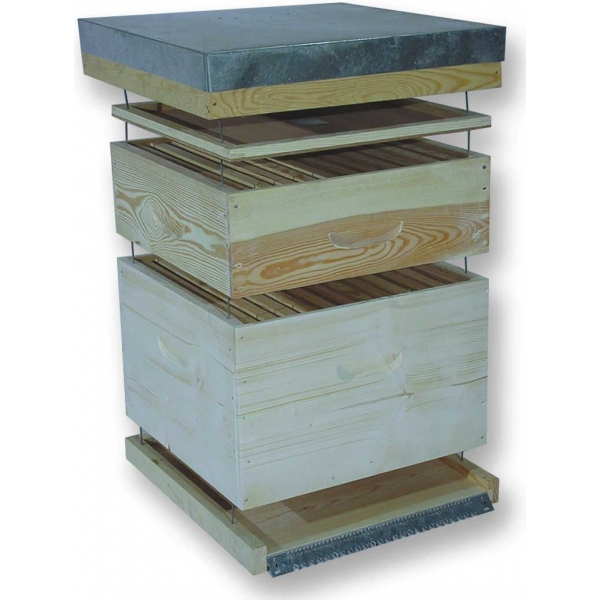
Alpine
Multicase hive. Creator of the French beekeeper Roger Delon. Made on the principle of hollow. That is, the natural living conditions of the bees have been created and taken into account.
Compact design is convenient for limited places.. It does not have partitions and vents. Air naturally enters through the entranceway.
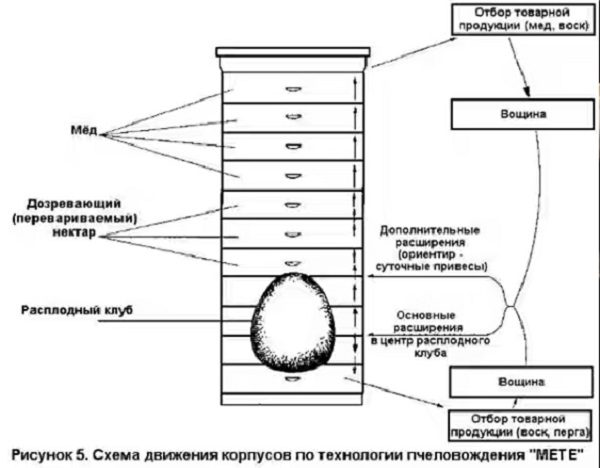
Ruta
This homemade bee house intended for keeping bees in the southern regions, because due to the constant permutations of buildings there is a supercooling of the house. Consists of 6 buildings with 10 frames each.
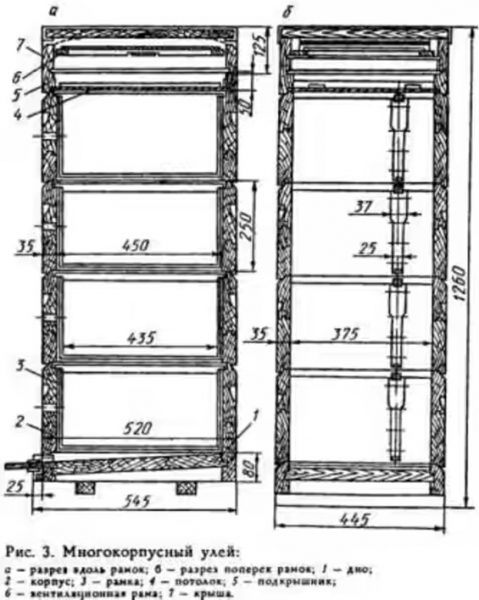
Cassette
Due to the growing incidence of bees among beekeepers, cassette hives have become popular. Such evidence possess thin partitions, therefore bees create a microclimate independently.
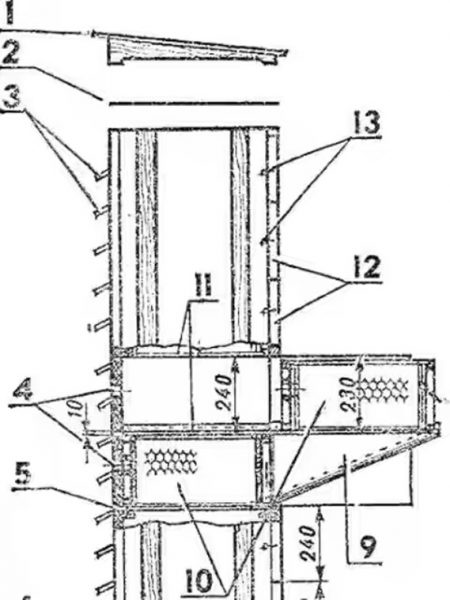
Ukrainian lounger
This design of the hive in size most suitable for beginners. They are easy to maintain. Easy to build, which will allow you to master the skills of beekeeping. Usually such a hive for 20 frames. The sides of the house are insulated, so the bees in them winter well.
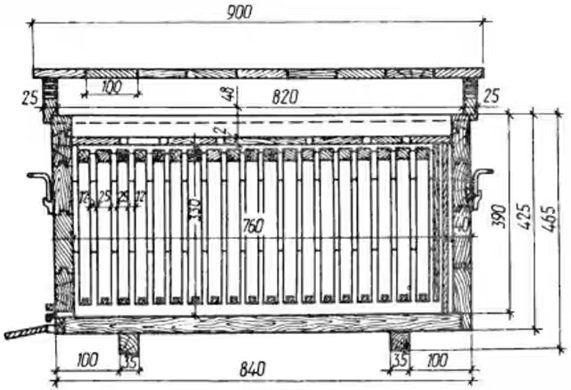
There are many constructs of evidence, but we will dwell in more detail on the classic, lounger with a different number of frames and multi-case, non-balck.In this case, there are hives loungers 16, 20 and 24 frames.
How to build a classic hive step by step
Because of its ease of manufacture, the Dadanovsky hive is considered the classic version.
The classic design for the production of the hive consists of:
- One or more enclosures.
- One or two stores.
- Under the liner.
- The bottom of the hive.
- The ceiling.
- Roofs.
- Framework.
- Troughs.
- Insertion board.
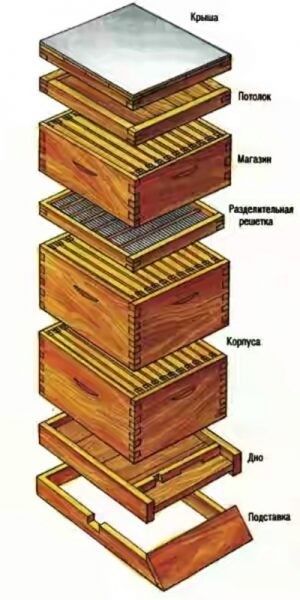
Instruction house for bees with drawings
Now let's talk about how to make your own hive step by step. The size of the hive for bees can be very different, but we will focus on one option. For this you will need:
- pick up material (linden, pine, cedar, spruce, polystyrene, polyurethane, foam), it must be dried;
- boards take 4 cm thick, go to the manufacture of the bottom and hull;
- make grooves in the boards to connect the walls of the hull;
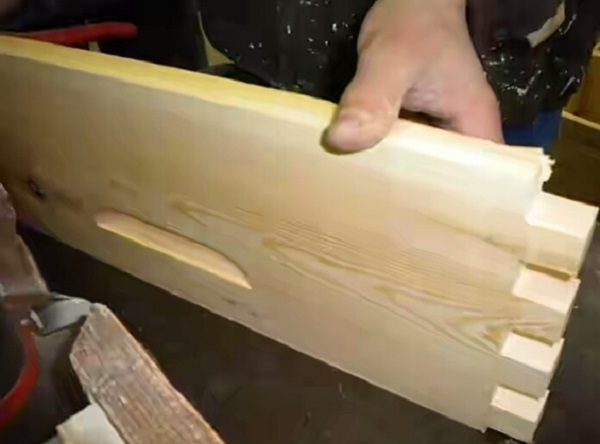
Start assembling the hive. Preparation of boards for the house of bees. - make strips 18 * 4 mm;
- connect the boards into boards; for this purpose, we grease the grooves with PVA glue or liquid nails and firmly press them together;
- you need to make five walls (one will be the bottom);
- connect walls together;
- going to the lower body;
- paint the hive with acrylic paints and let dry;
- need to drill cells.
The cover and the liner require a board 15 mm thick. Collect and cover with tin to prevent water from entering. To paint. Make vents in diameter 1.4 cm.
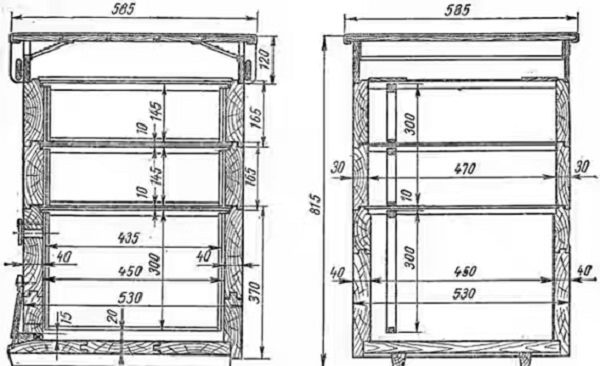
Dimensions:
- rear and front shield (cm): width 53, height 32, thickness 4.
- side shield (cm): width 48, height 32, thickness 4.
- inner (cm): width 45, height 45, thickness 32.
In order to place the frame in the case, you need to make folds.
Dimensions 1.1 * 2 cm.
If there is a multi-bee hive, then the dimensions will be different: 1 * 1.4 cm.
Drawing 12 frame hive:
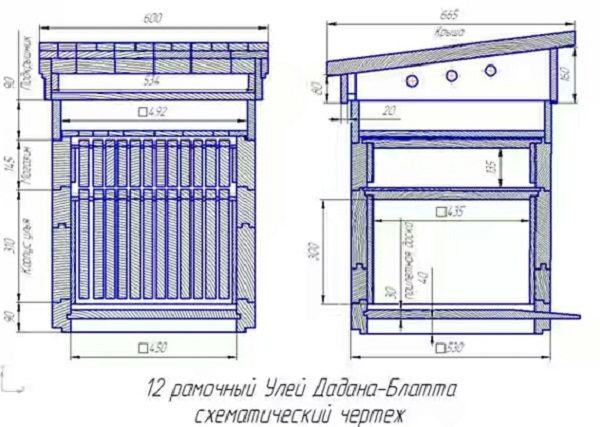
Drawing 10 frame hive:
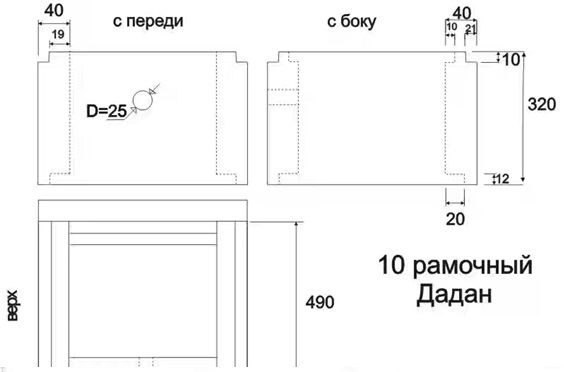
The frame is in the nest - 43.5 * 30 cm;
The frame is 43.5 * 14.5 cm;
The distance from the walls of the hull to the side slats is 0.07 cm;
The space under the frame - 2.5 cm;
Width of the side frame - 3.7 cm.
Beehive lounger 16, 20 and 24 frames: drawings and dimensions
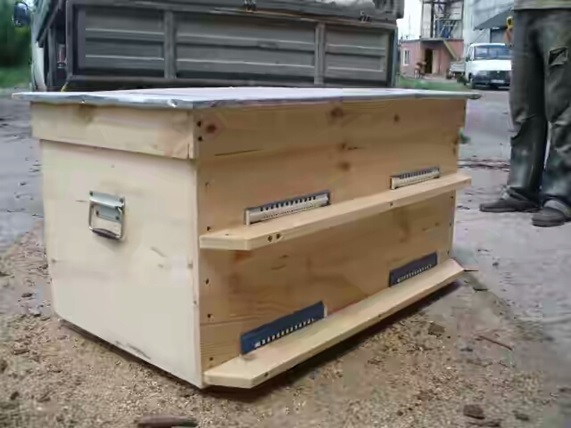
What tools and material will you need?
- Wood, plywood, foam.
- Rulers, or tape measures.
- Squares;
- Hacksaws
- Hammers.
- Drill, drill, screws.
- Chisels.
- Glue.
- Carrying handles.
- Galvanized sheet for roof.
- Frames in the amount of 24 pieces.
Hive sizes:
- frames 30 * 43.5 cm;
- body (cm): length 87, width 56.5, height 63.5;
- roof length (cm): outside 93.5, inside 81;
- bottom thickness 3.5 cm;
- lower notch - 1.2 * 14 cm;
- upper notch - diameter 2.5 cm.
Instructions for making the hive 24 frames
- From the prepared material cut according to the drawings details.
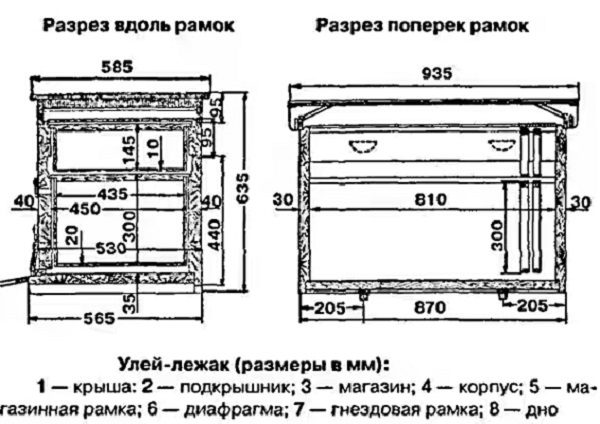
- Collect the bottom. Connect the two slats and the flooring with the help of a primer and nails.
- Connect the side walls and attach to the bottom. Make a ledge behind the bars 2 cm.
- On the front and rear walls make grooves for the frames. The size is 1.8 * 1.1 cm.
- Bottom cut openings.
- To attach the latch and the flight board.
- Make a roof. Fasten the boards with nails in the spike.
- Attach hinges to the roof.
- Hit the roof with tin.
- On the back side of the roof, make a ventilation hole of 20 * 0.03 cm.
- On the front wall Drill a hole with a diameter of 2.5 cm.
- Cover them with a grid.
- To the bottom of sturdy legs.
- Molded and painted.
- Attach the handles to make it comfortable when carrying.
How to make evidence lounger 20 and 16 frames
It is produced on the same principle with a difference in size.
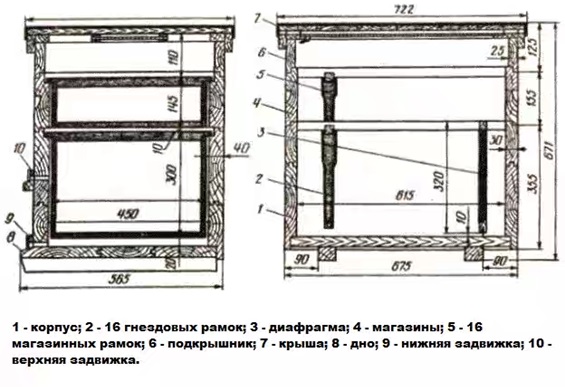
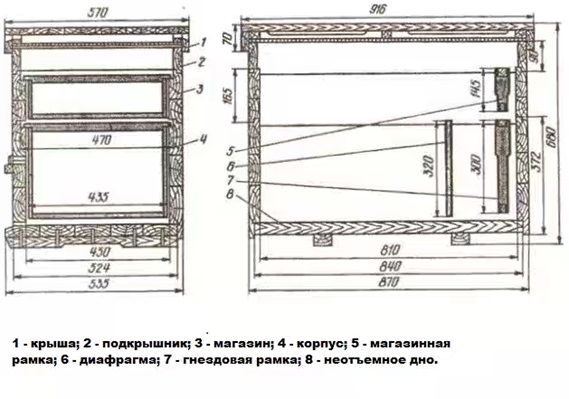
Multicase befaltless hive: dimensions and drawings.
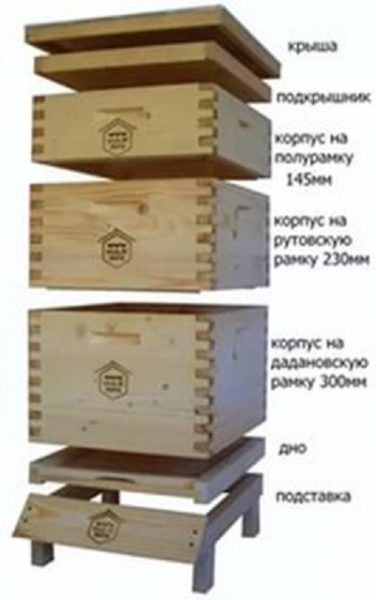
For many years, this hive has not lost its popularity in use. Convenient design allows them to use everywhere. Yes, and in making it simple.
In order to properly build a hive, you need to know what the structure consists of:
- Cap.
- Ceilings or ceiling.
- The shops.
- Corps.
- Bottom.
- Stand.
- Framework.
- Dividing grid.
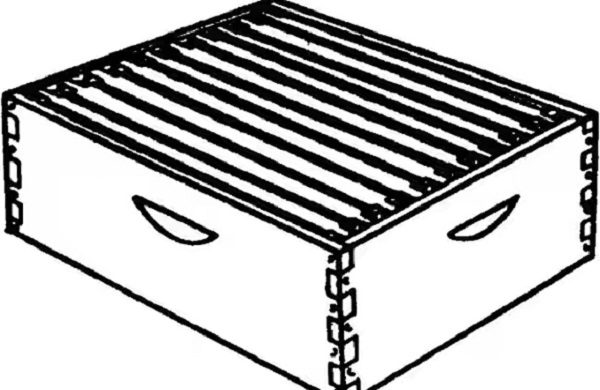
The body looks like a box. Its size from the inside (cm): width 37.5; length 45; 24 high.
It includes 10 - 12 frames of 43.5 * 23 cm in size.
Reducing the size leads to inconvenience in working with frames. It is impossible to get them when they are heavily spilled or swollen from moisture. Therefore, some increase the width of the case to 38 cm.
For the manufacture of buildings need to take carefully dried boards. They must dry out for a year.When cutting parts, boards should be with a small margin (3-5 mm). The stock is left for further fitting parts. It is recommended to leave 1 cm for trimming.
On the front and rear parts of the case make folds to put frames on them. Size 1.1 and 1.7 cm. This depth allows you to freely put the upper case.
On the side walls you need to attach handles or small depressions.
A 25 mm hole is drilled from the end of the hive under the roof to ventilate the house.
Boxes with frames tightly connected to each other. It does not use folds. Such a constructive solution is more convenient to use and easy to build.
You should also read about:
- The healing properties of propolis ointment.
- The secrets of treatment tincture of wax moth and recipes for its preparation.
- How to determine the quality and the naturalness of honey.
In cases with the use of folds during transportation or movement, bees are most often hammered into the lower part and hide in the fold recesses, subsequently die. Most often, the uterus dies in them and the beekeepers abandoned such hives in favor of a faceless structure.
For the manufacture of the roof is taken a plate thickness of 2 cm.From it the guard which is covered with a galvanized tin is knocked together.
The bottom is better to make removable, two-sided.
- three bars 57 * 6.5 * 3.5 cm - lateral;
- one 44.5 * 6.5 * 3. cm set at the back.
Make grooves in them. Width 3.5 and depth 1 cm. Assemble p - shaped structure. The grooves are designed to install the floor plate.
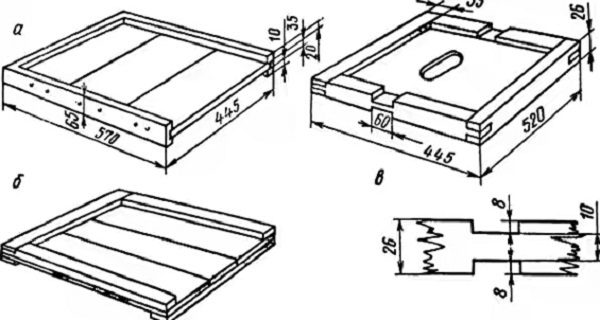
It is necessary to provide a protrusion before 50 mm. It serves as a flight board.
Cover plate (ceiling) - solid shield assembled from dies, 52 * 44 cm in size. Around it is a bezel made of slats. Their width is 3.5 and the thickness is 1.5 cm. A hole is made in the center. It is necessary for ventilation between the buildings or a feeder is placed on it.
On the case, the liner is placed on the smooth side without a rim.that allows the bees to move freely. It can also serve as a dividing grid, in this case a grid is stuffed into the hole.
Stand.It is made of bars according to the size of the bottom. In front of a wide dash pin at an angle of 45 °. This will be a flight board.

In the side bars cut out the recess size 2.5 * 9 cm. They are intended for convenience when you need to lift the hive or fix when moving.
The size of the separation grid.Intended to isolate the temporary isolation of the uterus. To separate the body from the brood from the honey.
The size of the grille must match with the size of the inner shell. She put on the bars. Made from wire mesh.
The size of the frame.Case and store frames, you can also do it yourself. They must comply with the drawings.
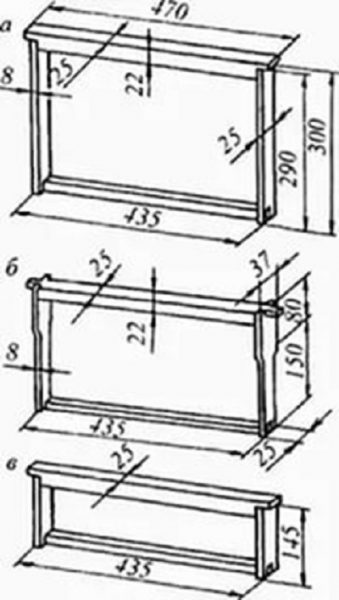
Drawings of multiple hives.
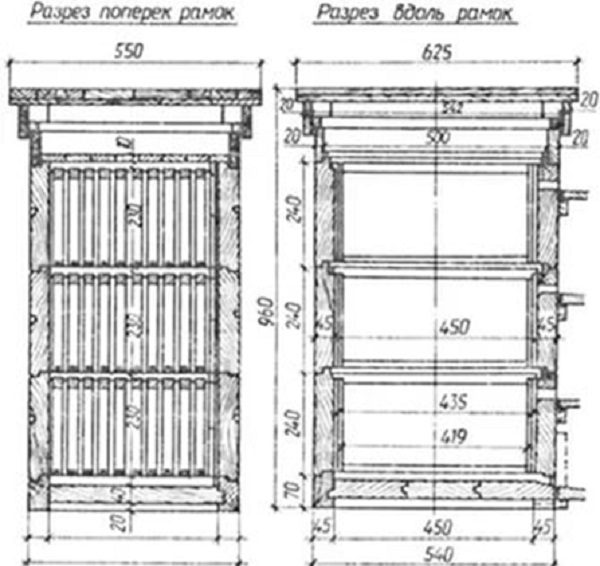
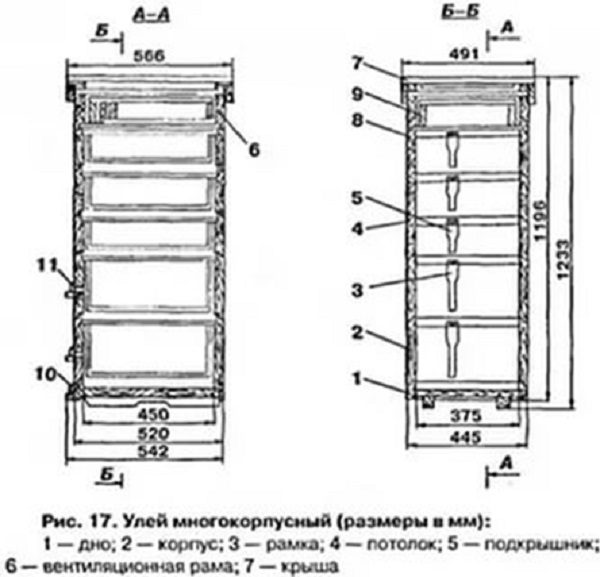
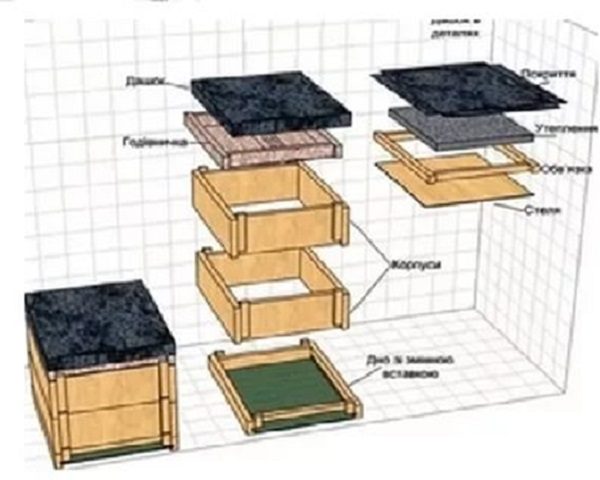
Frames in the hive: the size and description of how to do it yourself
Frames are an important part in hives and the main work is being done with them. From constant use, they become unusable and need to be added. Therefore, the beekeeper should always have a large stock. To save them, it is better to make them yourself than to constantly buy.
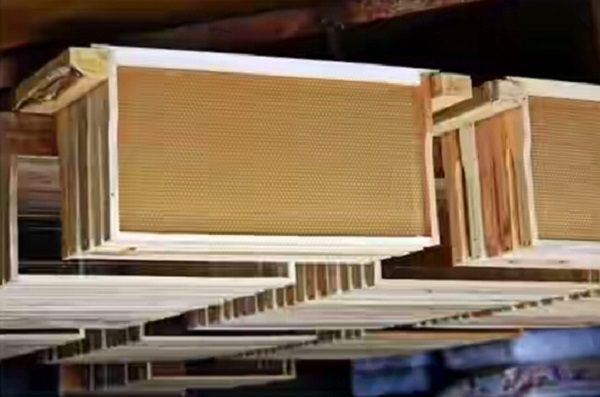
For the manufacture of frames use the following tools:
- a hammer;
- pliers;
- an awl;
- shoe nails;
- a coil of fine wire.
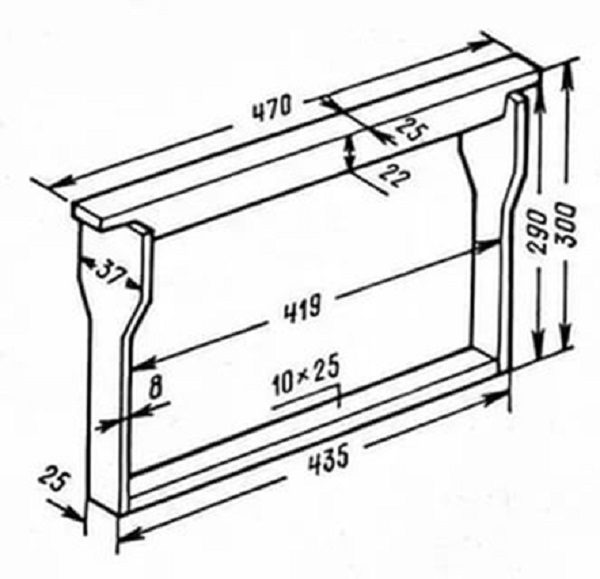
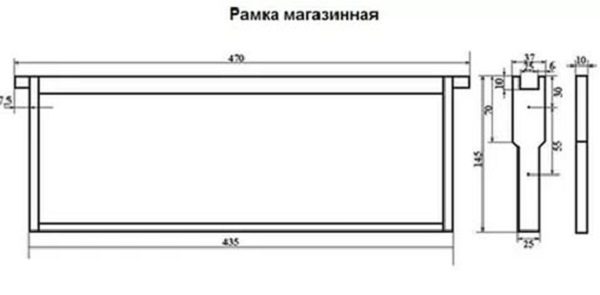
For manufacturing use natural materials. It is better if it is dried during the year of the board. To make a frame you need to know what parts it consists of:
Upper bar.
Grooved or uniform.
Bottom bar.
Normal, grooved or cross-cutting.
Side bars.
They have holes for stretching the wire under the plate.
The size of the frame depends on the design of your hive. Standard sizes are:
- width of the top and side frames 2.5 cm;
- the height of the upper stone is 2 cm;
- width lower 1.5 - 2.5 cm;
- height 1 cm;
- external dimensions range from the hive design, but usually 43.5 * 30 cm.
Once you have chosen the material and decided on the dimensions, we proceed to the direct production of the frame.
- From dry boards to cut parts by the size of the drawing.
- Using shoe nails to connect all the details.
- Drill 4 holes and two double for fixing the wire on the side slats. The distances between the holes should be equal.
- Tension the wire. Start from the top hole and pull it over with the snake. Take care that the wire does not cross anywhere. Secure it securely so that heavy cells don't accidentally break off. As a result, you should get 4 lines.
On the framework prepared in such a way, the wholeness is fixed.
Now you know how to make your own bee hives with drawings. Using the drawings and sizes you can easily build it yourself, thereby saving the budget and providing the bees with comfortable living conditions.
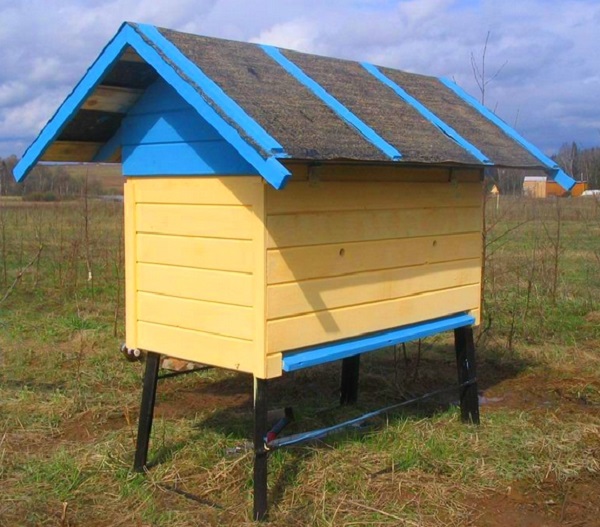
All the time I make hives myself, it turns out to be an order of magnitude cheaper, and you also answer for the quality. And, although I live in Ukraine, I do not use sunbeds, only multi-body ones. As for me they are more convenient, you can always add a case if necessary.